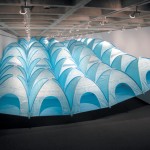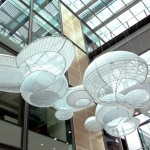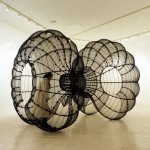SB: Please tell me about your educational background. Where did you go to school? What did you study (or were there multiple subjects that influenced art)? What was your experience like a student like? What did you take from school that continues to help you today? If you could be a student again, what would you do differently?
KB: I first studied Microbiology at the University of Alabama in Tuscaloosa in 1972-1976. This was the state university and where I grew up, in rural Alabama, one pretty much went to either Auburn University or the University of Alabama if you were from that area. I majored in science in that that was the most interesting department to me and I loved the microscopic work. I was always interested in drawing and making things, but I liked biology too! Also keep in mind where I went to high school there was no art program. And the rural Southern community did not offer lots of opportunities to visit museums and see original art! So a career in art was a mystery to me. So I graduated with a BA in Medical Technology and then later ended up in Washington DC working in a laboratory. While in DC I discovered museums. I went to the Hirshhorn and the new East Wing of the National Gallery and began taking first adult evening and then open program art classes between working in the laboratory- not being sure where this would lead. I then got more serious and took post-bac classes with Anne Truitt at the University of Maryland and Gene Davis at the Corcoran and then decided to go full time and went on to get my BFA from the Corcoran in 1981. I stayed in DC and showed my work at the Washington Project for the Art (an alternative space) and then was in a big show at the Hirshhorn (Direction 1983) and then after a couple of years did the Whitney Independent Study Program in 1984 and a year later my MFA in sculpture at Yale.
At the University of Alabama I think I learned to be independent and perhaps for me it was good that I had a very structured course of study at that age. I came from a small town and the freedom was intoxicating. So who knows if I would have had the necessary self- discipline and focus to make the most of an art course at that time. Also it was 1972 – so the world was changing so fast! So it was about finding my identity as distinct from my southern conservative family. It was a full time task! I also shopped a bit for a major so I had quite a few credits in psychology as I was at one time thinking I might do pre-med or clinical psychology.
My work in the laboratory taught me to work with a team, to appreciate doing a job – not feeling that I was a creative genius owed something by the rest of the world! Working with sick children (my first lab job was in a children’s hospital) taught me to have a perspective on what is important.
My art training at the Corcoran was a very process /conceptual based program and taught me how to develop a real studio practice not a project-to-project approach, to generate ideas and identify my own area of research. Also, because of the Corcoran I think I tend to see technical mastery as following conceptual development rather than the other way round. We had limited shop facilities so we were forced to improvise and invent! The Corcoran was naturally as cross-disciplinary program so I worked across painting, drawing, filmmaking, installation and writing.
The Whitney Program was an intensive theory based experience. So I feel like once and for all I did not have to be mystified by certain terms and concepts that were becoming such a central part of art theory – terms that one encountered reading most any art journal at that time. Yale taught me to be less afraid of diving into materials. (In 1984 it was a pretty traditionally post-minimal program – where making and truth to materials were really privileged.) So each of the three educational experiences were unique, even contradictory, and yet each gave me something.
The Corcoran experience could not have been more perfect. I had been in a laboratory, working on my own, taking classes here and there. At the Corcoran for the first time I had a real super community of peers. This was 1980/81. So as far as my undergraduate studies go would change nothing! Maybe I wish the Corcoran had the facilities VCU has, but I got so much out of learning my process and working 24/7 in the studio. (Like VCU CSA provided individual studios. So you were expected to make this a life – not a ‘check it off the list now that I am done with earning the credits’ class!)
I wish I had been more prepared in terms of theory at the Whitney so I could have built more on the incredible (though very narrow) expertise there. As it was I got much out of it – but was really struggling to do so much remedial work in theory!
Yale? If I could do this again I would have socialized less and gone to more classes offered in the greater university. But it was still a great experience. Maybe spent more time in New Haven (I was living in New York City and commuting at the time – so I was back and forth a lot.)
SB: What do you do in your current job? What is an average day like? What do you most enjoy about your job? What do you find most challenging?
KB: I teach in the Department of Sculpture and Extended Media. We teach all levels so depending on the semester this might be a Basic Studio class, an intermediate/advanced studio class, a graduate seminar, or graduate intensive critique class or in my case professional practices undergraduate seminar or undergraduate reading seminar. We also all teach grads so even if we are not teaching the grad classes as such we are on review committees to do mid-term and end of term reviews. Also we do studio visits, as requested, which is often!! On an average teaching day I go in at least an hour to an hour and a half early (I like to get my bearings and settled!) And if I am doing an all day studio class I make sure the shop is ready for demos – or if it is a critique day I check on the critique set up. For the reading seminar I review my readings, set up any Powerpoints, etc. I guess what I am saying is I like to be in, focused and have my things put away and organized before the students arrive! I seldom have lunch! Someone catches you! That’s OK! And seldom leave at end of day! Sculpture is a community and there is always something being set up in the critique room you want to see even if it is someone else’s class, or a visiting artist even on your day not teaching. And we faculty talk and compare notes on what is going on in the classroom.
I love teaching because it reminds me why I got into art in the first place! What could be a better job that working with artists discovering for the first time their creative potential. I learn so much from them! Most challenging is trying to juggle the big three. Research (making work, showing work, developing opportunities to show work) with teaching, and service, which can be anything from committees, reports, doing your bit for the department with open houses, search committees, peer reviews, and organizing student shows and off campus activities. So it is not so much anything you don’t like to do – it is just so much to do!!
SB: What skills are most essential to your job? How did you acquire these skills?
KB: Communication. Communication. Communication. You need to be able to talk with your students show respect and seriousness but humor. Show compassion, but set high standards. Treat each student fairly but know each has different needs and different communication modes.
I don’t know really know how I acquired these skills? Is it a skill or a personality type? A passion?! I think I truly love teaching and truly am interested in my student’s work and growth. You can’t fake that. It can’t be just a job!
SB: How did you get where you are today (important connections you made, skills acquired, actions you took, opportunities, etc)?
KB: I was a very dedicated student at the Corcoran and when I finished at Yale I got a break to do adjunct. I also did adjunct at MICA and VCU. Though I was adjunct I treated the jobs like they were my number one focus. Be the first to arrive and last to leave.
SB: What advice would you give to a younger artist who is interested in pursuing the career you’re in?
KB: Don’t do this unless you love to teach and truly care about another persons’s work and growth. Listen. Learn. Be strict, but fair. If a student does a poor job and you have done your best to teach them then they are not ready to learn -they may need to mature more. I have seen too many young teachers get impatient with students and internalize what is that student’s struggle. Be there to help, but cultivate healthy boundaries.
SB: How important is networking in the art world (for shows, job opportunities, and being in the know)?
KB: Very. Every job I got was through contacts THROUGH WORKING HARD ON A JOB!!!!
SB: What are the most beneficial settings /environments for young artists to be in today?
KB: Any city you like with a vibrant art community. (But then maybe you need a community in a natural environment!) I am thinking community is the key here!!! Urban or rural!
SB: How do you balance studio practice with other aspects of your life? Is cross-over between the two important? Is there even a need to distinguish?
KB: It is challenging for sure! Frankly I have developed a studio practice where, as projects become more numerous, I find that I rely more and more on assistance to fabricate and manage the projects. This is natural. But teaching though it is more and more time consuming it seems, also feeds my creative side very much. I am exposed to new work and constantly stimulated! Also the practical stability of a teaching job is something for which I am deeply grateful.
SB: In what ways has your art changed over time? What critical discoveries have you made while working on art?
KB: I began with making installation in my studio in 3rd year undergrad – just painting on the walls and floor to make 3-D paintings one could enter. I then did canvases that were clamped together – again 3-D paintings as architecture! Later I did objects for a bit in grad school to experiment with materials, but soon returned to the earlier ideas of works that one could enter. I am currently working with object /architecture and large works that are permanent installations in various architectural spaces. I am doing mostly these permanent commissioned installations now. So my studio practice has evolved from a workshop for one to a managed large-scale production!
SB: What surprises you in your job or art?
KB: In my job I am constantly surprised by my students – their thinking processes and inventiveness, How they often will come up with work that surpasses my expectations. In my job I am constantly surprised by how I think I am getting bored and then BOOM we have a faculty meeting and cook up a new potential project or a student does a cool work and I am back feeling like it is my first day!
My art? Well last month I get an invitation to do something that is a little scary. In the spring I am doing a series of temporary collapsible structures for an event in Phoenix to celebrate the new Paolo Solari Bridge in Scottsdale and the Summer Solstice. This is requiring some new technical challenges. But I have wanted to do this for some time – to explore the concept of the model in a more light – low impact form. Tent – like structures rather than the welded frames and skins. So this is exciting for me.




